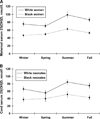High prevalence of vitamin D insufficiency in black and white pregnant women residing in the northern United States and their neonates
- PMID: 17237325
- PMCID: PMC4288960
- DOI: 10.1093/jn/137.2.447
High prevalence of vitamin D insufficiency in black and white pregnant women residing in the northern United States and their neonates
Abstract
In utero or early-life vitamin D deficiency is associated with skeletal problems, type 1 diabetes, and schizophrenia, but the prevalence of vitamin D deficiency in U.S. pregnant women is unexplored. We sought to assess vitamin D status of pregnant women and their neonates residing in Pittsburgh by race and season. Serum 25-hydroxyvitamin D (25(OH)D) was measured at 4-21 wk gestation and predelivery in 200 white and 200 black pregnant women and in cord blood of their neonates. Over 90% of women used prenatal vitamins. Women and neonates were classified as vitamin D deficient [25(OH)D<37.5 nmol/L], insufficient [25(OH)D 37.5-80 nmol/L], or sufficient [25(OH)D>80 nmol/L]. At delivery, vitamin D deficiency and insufficiency occurred in 29.2% and 54.1% of black women and 45.6% and 46.8% black neonates, respectively. Five percent and 42.1% of white women and 9.7% and 56.4% of white neonates were vitamin D deficient and insufficient, respectively. Results were similar at <22 wk gestation. After adjustment for prepregnancy BMI and periconceptional multivitamin use, black women had a smaller mean increase in maternal 25(OH)D compared with white women from winter to summer (16.0+/-3.3 nmol/L vs. 23.2+/-3.7 nmol/L) and from spring to summer (13.2+/-3.0 nmol/L vs. 27.6+/-4.7 nmol/L) (P<0.01). These results suggest that black and white pregnant women and neonates residing in the northern US are at high risk of vitamin D insufficiency, even when mothers are compliant with prenatal vitamins. Higher-dose supplementation is needed to improve maternal and neonatal vitamin D nutriture.
Conflict of interest statement
The authors do not declare any conflicts of interest.
Figures


Comment in
-
Vitamin D deficiency in pregnancy: bringing the issues to light.J Nutr. 2007 Feb;137(2):305-6. doi: 10.1093/jn/137.2.305. J Nutr. 2007. PMID: 17237301 No abstract available.
References
-
- Welch TR, Bergstrom WH, Tsang RC. Vitamin D-deficient rickets: the reemergence of a once-conquered disease. J Pediatr. 2000;137:143–145. - PubMed
-
- Kreiter SR, Schwartz RP, Kirkman HN, Jr, Charlton PA, Calikoglu AS, Davenport ML. Nutritional rickets in African American breast-fed infants. J Pediatr. 2000;137:153–157. - PubMed
-
- Pugliese MT, Blumberg DL, Hludzinski J, Kay S. Nutritional rickets in suburbia. J Am Coll Nutr. 1998;17:637–641. - PubMed
-
- Sills IN, Skuza KA, Horlick MN, Schwartz MS, Rapaport R. Vitamin D deficiency rickets. Reports of its demise are exaggerated. Clin Pediatr (Phila) 1994;33:491–493. - PubMed
-
- Tomashek KM, Nesby S, Scanlon KS, Cogswell ME, Powell KE, Parashar UD, Mellinger-Birdsong A, Grummer-Strawn LM, Dietz WH. Nutritional rickets in Georgia. Pediatrics. 2001;107:E45. - PubMed
Publication types
MeSH terms
Substances
Grants and funding
LinkOut - more resources
Full Text Sources
Other Literature Sources
Medical

